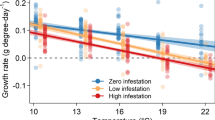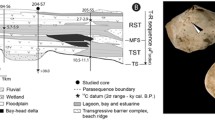Abstract
Besides the direct impact on the general performance of individual organisms, the ecological consequences of climate change in terrestrial and marine ecosystems are expected to be determined by complex cascading effects arising from modified trophic interactions and competitive relationships. Recently, the synergistic effect of parasitism and climate change has been emphasised as potentially important to host population dynamics and community structure, but robust empirical evidence is generally lacking. The amphipod Corophium volutator is an ecologically important species in coastal soft-bottom habitats of the temperate North Atlantic, and commonly serves as host to microphallid trematodes that cause intensity-dependent and temperature-dependent mortality in the amphipod population. Using a simulation model parameterised with experimental and field data, we demonstrate that a 3.8°C increase in ambient temperature will likely result in a parasite-induced collapse of the amphipod population. This temperature increase is well within the range predicted to prevail by the year 2075 in the International Wadden Sea region from where the model data are obtained. Due to the amphipods’ ecological importance, their population decline may impact the coastal ecosystem as a whole.



Similar content being viewed by others
References
Bick A (1994) Corophium volutator (Corophiidae:Amphipoda) as an intermediate host of larval digenea—an ecological analysis in a coastal region of the southern Baltic. Ophelia 40:27–36
Bishop CA, Threlfall W (1974) Helminth parasites of common eider duck, Somateria mollissima (L.), in Newfoundland and Labrador. Proc Helminthol Soc Was 41:25–35
Bush AO, Forrester DJ (1976) Helminths of white ibis in Florida. Proc Helminthol Soc Was 43:17–23
Christensen OB, Christensen JH, Machenhauer B, Botzet M (1998) Very high-resolution regional climate simulations over Scandinavia—present climate. J Climate 11:3204–3229
Christensen JH, Raisanen J, Iversen T, Bjorge D, Christensen OB, Rummukainen M (2001) A synthesis of regional climate change simulations—a Scandinavian perspective. Geophys Res Let 28:1003–1006
Cotton PA (2003) Avian migration phenology and global climate change. Proc Natl Acad Sci USA 100:12219–12222
Daborn GR, Amos CL, Brylinsky M, Christian H, Drapeau G, Faas RW, Grant J, Long B, Paterson DM, Perillo GME, Piccolo MC (1993) An ecological cascade effect: migratory birds affect stability of intertidal sediments. Limnol Oceanogr 38:225–231
Evans NA (1985) The influence of environmental temperature upon transmission of the cercariae of Echinostoma liei (Digenea: Echinostomatidae). Parasitology 90:269–275
Fish JD, Mills A (1979) The reproductive biology of Corophium volutator and C. arenarium (Crustacea:Amphipoda). J Mar Biol Ass UK 59:355–368
Fredensborg B, Latham DL, Poulin R (2004) New records of gastrointestinal helminths from the red-billed gull (Larus novaehollandiae scopulinus). N Z J Zool 31:75–80
Gerdol V, Hughes RG (1994) Effect of Corophium volutator on the abundance of benthic diatoms, bacteria and sediment stability in two estuaries in southeastern England. Mar Ecol Prog Ser 114:109–115
Ginetsinskaya TA (1988) Trematodes, their life cycles, biology and evolution. Amerind Publishing Co., New Delhi
Gratto GW, Thomas MLH, Gratto CL (1984) Some aspects of the foraging ecology of migrant juvenile sandpipers in the outer Bay of Fundy. Can J Zool 62:1889–1892
Harvell CD, Mitchell CE, Ward JR, Altizer S, Dobson AP, Ostfeld RS, Samuel MD (2002) Climate warming and disease risks for terrestrial and marine biota. Science 296:2158–2162
Holmgren M, Scheffer M, Ezcurra E, Gutierrez JR, Mohren GMJ (2001) El Niño effects on the dynamics of terrestrial ecosystems. Trends Ecol Evol 16:89–94
Hudson PJ, Dobson AP, Newborn D (1998) Prevention of population cycles by parasite removal. Science 282:2256–2258
Hughes RG (1988) Dispersal by benthic invertebrates—the in situ swimming behavior of the amphipod Corophium volutator. J Mar Biol Ass UK 68:565–579
Hylleberg J (1975) The effect of salinity and temperature on egestion in mud snails (Gastropoda: Hydrobiidae). A study on niche overlap. Oecologia 21:87–92
IPCC (2000) Special report on emission scenarios (SRES): a special report of working group III of the intergovernmental panel on climate change. Cambridge University Press, Cambridge
Jensen KT, Kristensen LD (1990) A field experiment on competition between Corophium volutator (Pallas) and Corophium arenarium Crawford (Crustacea:Amphipoda): effects on survival, reproduction and recruitment. J Exp Mar Biol Ecol 137:1–24
Jensen KT, Mouritsen KN (1992) Mass mortality in two common soft-bottom invertebrates, Hydrobia ulvae and Corophium volutator: the possible role of trematodes. Helgol Meersunters 46:329–339
Laursen K, Frikke J (1984) The Danish Wadden Sea. In: Evans PR, Goss-Custard JD, Hale WG (eds) Coastal waders and wildfowl in winter. Cambridge University Press, Cambridge, pp 214–223
Matthews SL, Boates JS, Walde SJ (1992) Shorebird predation may cause discrete generations in an amphipod prey. Ecography 15:393–400
McCarthy AM (1999) The influence of temperature on the survival and infectivity of the cercariae of Echinoparyphium recurvatum (Digenea: Echinostomatidae). Parasitology 118:383–388
Meadows PC, Ruagh AA (1981) Temperature preferences and activity of Corophium volutator (Pallas) in a new choice apparatus. Sarsia 66:67–72
Meissner K, Bick A (1997) Population dynamics and ecoparasitological surveys of Corophium volutator in coastal waters in the Bay of Mecklenburg (south Balthic Sea). Dis Aquat Org 29:169–179
Meissner K, Bick A (1999a) Laboratory studies of parasite transmission aspects between Hydrobia spp. (Gastropoda) and Corophium volutator (Amphipoda). Internat Rev Hydrobiol 84:61–72
Meissner K, Bick A (1999b). Mortality of Corophium volutator (Amphipoda) caused by infestation with Maritrema subdolum (Digenea, Microphallidae): laboratory studies. Dis Aquat Org 35:47–52
Minchella DJ, Scott ME (1991) Parasitism: a cryptic determinant of animal community structure. Trends Ecol Evol 6:250–254
Mouritsen KN (1994) Day and night feeding in dunlins Calidris alpina: choice of habitat, foraging technique and prey. J Avian Biol 25:55–62
Mouritsen KN (2002) The Hydrobia ulvae—Maritrema subdolum association: influence of temperature, salinity, light, water-pressure and secondary host exudates on cercarial emergence and longevity. J Helminthol 76:341–347
Mouritsen KN, Jensen KT (1997) Parasite transmission between soft-bottom invertebrates: temperature mediated infection rates and mortality in Corophium volutator. Mar Ecol Prog Ser 151:123–134
Mouritsen KN, Poulin R (2002a) Parasitism, climate oscillations and the structure of natural communities. Oikos 97:462–468
Mouritsen KN, Poulin R (2002b) Parasitism, community structure and biodiversity in intertidal ecosystems. Parasitology 124:S101–S117
Mouritsen KN, Poulin R (2005) Parasites boost biodiversity and change animal community structure by trait-mediated indirect effects. Oikos 108:344–350
Mouritsen KN, Jensen T, Jensen KT (1997) Parasites on an intertidal Corophium-bed: factors determining the phenology of microphallid trematodes in the intermediate host populations of the mud-snail Hydrobia ulvae and the amphipod Corophium volutator. Hydrobiologia 355:61–70
Mouritsen KN, Mouritsen LT, Jensen KT (1998) Changes of topography and sediment characteristics on an intertidal mud-flat following mass-mortality of the amphipod Corophium volutator. J Mar Biol Ass UK 78:1167–1180
Mouritsen KN, Gorbushin A, Jensen KT (1999) Influence of trematode infections on in situ growth rates of Littorina littorea. J Mar Biol Ass UK 79:425–430
Mysterud A, Stenseth NC, Yoccoz NG, Langvatn R, Steinheim G (2001) Nonlinear effects of large-scale climatic variability on wild and domestic herbivores. Nature 410:1096–1099
Ottersen G, Planque B, Belgrano A, Post E, Reid PC, Stenseth NC (2001) Ecological effects of the North Atlantic oscillation. Oecologia 128:1–14
Peer DL, Linkletter LE, Hicklin PW (1986) Life history and reproductive biology of Corophium volutator (Crustacea:Amphipoda) and the influence of shorebird predation on population structure in Chignecto Bay, Bay of Fundy, Canada. Neth J Sea Res 20:359–373
Rehfisch MM, Austin GE, Freeman SN, Armitage MJS, Burton NHK (2004) The possible impact of climate change on the future distribution and numbers of waders on Britain’s non-estuarine coast. Ibis 146:S70–S81
Schneider SD, Boates JS, Forbes M. (1994) Sex ratios of Corophium volutator (Pallas) (Crustacea:Amphipoda) in Bay of Fundy populations. Can J Zool 72:1915–1921
Stenseth NC, Mysterud A, Ottersen G, Hurrell JW, Chan K-S, Lima M (2002) Ecological effects of climate fluctuations. Science 297:1292–1296
Stock TM, Holmes JC (1987) Host specificity and exchange of intestinal helminths among 4 species of grebes (Podicipedidae). Can J Zool 65:669–676
Thul JE, Forrester DJ, Abercrombie CL (1985) Ecology of parasitic helminths of wood ducks, Aix sponsa, in the Atlantic flyway. Proc Helminthol Soc Was 52:297–310
Tompkins DM, Greenman JV, Robertson PA, Hudson PJ (2000) The role of shared parasites in the exclusion of wildlife hosts: Heterakis gallinarum in the ring-necked pheasant and the grey partridge. J Anim Ecol 69:829–840
Tompkins DM, White AR, Boots M (2003) Ecological replacement of native red squirrels by invasive greys driven by disease. Ecol Lett 6:189–196
Walther G-R, Post E, Convey P, Menzel A, Parmesan C, Beebee TJC, Fromentin J-M, Hoegh-Guldberg O, Bairlein F (2002) Ecological responses to recent climate change. Nature 416:389–395
Wang CL, Thomas F (2002) Egg production by metacercariae of Microphallus papillorobustus: a reproductive insurance? J Helminthol 76:279–281
de Wilde PAWJ, Berghuis EM (1978) Cyclic temperature fluctuations in a tidal mud-flat. In: Naylor E, Hartnoll RG (eds) Cyclic phenomenon in marine plants and animals. Pergamon Press, Oxford, pp 435–441
Wilson WH Jr, Parker K (1996) The life history of the amphipod, Corophium volutator: the effect of temperature and shorebird predation. J Exp Mar Biol Ecol 196:239–250
Acknowledgements
The work was funded by a grant to KNM from the Carlsberg Foundation (Denmark) and in part by a grant to RP from the Marsden Fund (New Zealand).
Author information
Authors and Affiliations
Corresponding author
Additional information
Communicated by Martin Attrill
Rights and permissions
About this article
Cite this article
Mouritsen, K.N., Tompkins, D.M. & Poulin, R. Climate warming may cause a parasite-induced collapse in coastal amphipod populations. Oecologia 146, 476–483 (2005). https://doi.org/10.1007/s00442-005-0223-0
Received:
Accepted:
Published:
Issue Date:
DOI: https://doi.org/10.1007/s00442-005-0223-0




